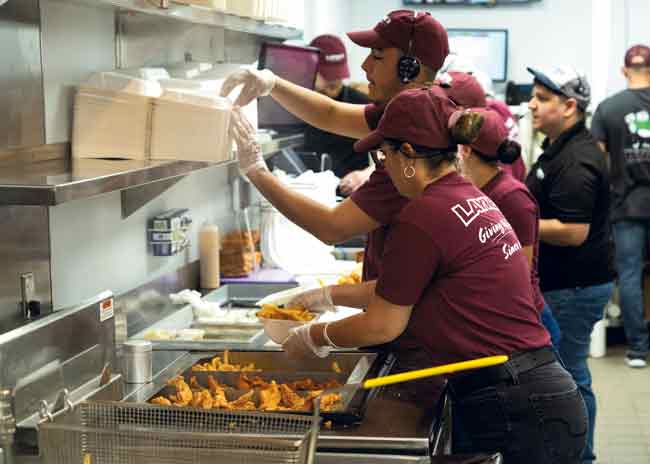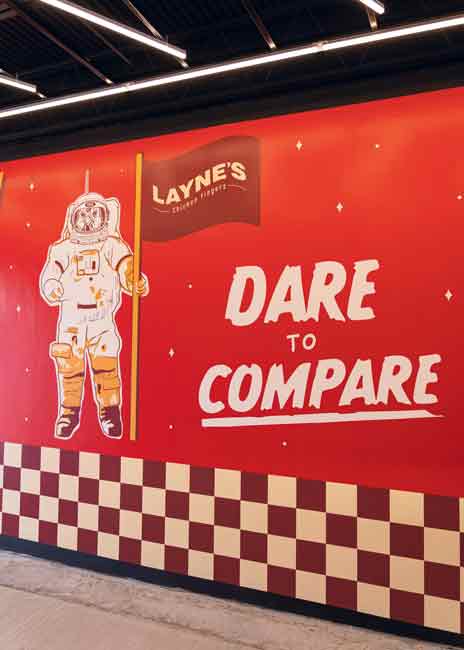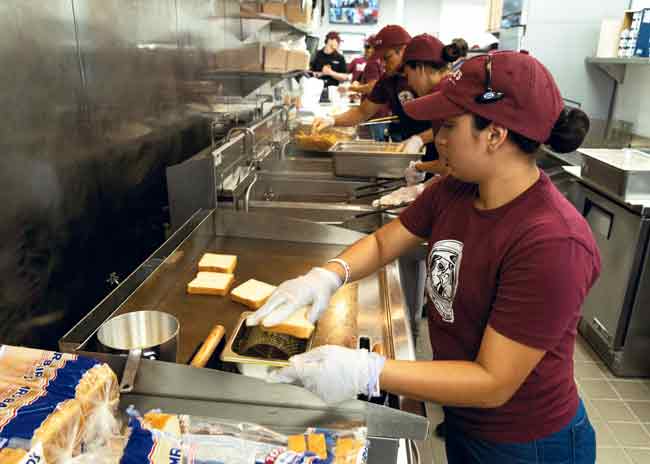After 20-plus years with just one or two locations and a devoted following, Layne’s Chicken Fingers expects to add several dozen locations in the next few years.
 If restaurants really do have cult followings, then Garrett Reed has gone from a mere follower to the man in the magic pajamas. Reed grew up in College Station, Texas, a town best known as the home of Texas A&M University. It’s also the birthplace of a small (but now growing) fast-casual fried chicken concept known as Layne’s Chicken Fingers.
If restaurants really do have cult followings, then Garrett Reed has gone from a mere follower to the man in the magic pajamas. Reed grew up in College Station, Texas, a town best known as the home of Texas A&M University. It’s also the birthplace of a small (but now growing) fast-casual fried chicken concept known as Layne’s Chicken Fingers.
Layne’s was founded in 1994, and Reed describes it as his “hometown chicken finger place.” With its “fantastic food” and fun, relaxed — even by college kid standards — setting, it’s a place where he’s enjoyed many meals. Plenty of people have felt the same way and enjoyed Layne’s just as much, ultimately making the restaurant a staple of life in College Station.
No matter how fervent its followers, though, Layne’s never grew beyond its home base. The concept’s owner was doing very well with just two locations, and the restaurant simply hadn’t been set up for growth, so duplicating it would be difficult. Why take on that challenge, that risk?
Taking the Helm
 Astrochicken is Layne’s key character and helps establish the chain’s fun attitude and atmosphere.Reed hasn’t spent his whole life in College Station. He built a successful career for himself a few hours north as a real estate developer in the Dallas area. The restaurant industry appealed to him, both as a business and as something of a new challenge, so Reed started looking for concepts to franchise. He wound up talking to Mike Garratt, owner of the hometown chicken place, and proposed becoming a franchisee.
Astrochicken is Layne’s key character and helps establish the chain’s fun attitude and atmosphere.Reed hasn’t spent his whole life in College Station. He built a successful career for himself a few hours north as a real estate developer in the Dallas area. The restaurant industry appealed to him, both as a business and as something of a new challenge, so Reed started looking for concepts to franchise. He wound up talking to Mike Garratt, owner of the hometown chicken place, and proposed becoming a franchisee.
“He said it wasn’t a franchise-able concept,” Reed says. “He was right. It wasn’t. It had a cult following, it had fantastic food, but it had no infrastructure. So me and my partner [Matt O’Reilly] acquired it in 2017 and invested a substantial amount of capital to create a franchise-able brand.”
Becoming a Franchise
In turning Layne’s into a franchise, the partners had to start almost from scratch. While there was the food and a loyal (but highly localized) customer base, the list of what Layne’s didn’t have was long. There were no standard operating procedures, operations manuals, brand standards or brand stamp. There wasn’t even a POS system. So the new owners spent the next year putting some of these puzzle pieces in place, then opened up a few locations as a proof of concept.
Three years and one pandemic later, Layne’s leaders thought they had “the secret sauce” for more efficient operations. The chain then brought on Samir Wattar, 30-year industry veteran, as chief operating officer.
“We figured out how to run restaurants efficiently and profitably, but we didn’t know how to be a franchisor,” Reed explains. “So we had to figure out how to be a service-based business. Samir was that key piece who took us from a restaurant business to a service-oriented business. We began to hire a training team, operations team, marketing team. We were building the infrastructure to be ready to roll out franchising.”
Wattar joined Layne’s in early 2021 and helped nail down the supply chain, operations manual and brand voice, among other efforts. The company’s first two franchise locations opened the next year. As of press time, Layne’s has four company-owned restaurants and six franchised locations. The chain expects to have around 17 locations total by the end of the year, and it has contracts for nearly 70 locations.
Part of the appeal of Layne’s is its edgy yet lighthearted nature. The company’s art package includes cartoons of controversial political figures such as Joseph Stalin accompanied by a note that “to our knowledge, no foreign dictators have eaten at Layne’s.” The interior design features multiple clocks showing what time it is at locations ranging from the parking lot to Uranus.
Then there’s Astrochicken, the chain’s intentionally ridiculous chicken-in-a-spacesuit mascot. Astrochicken represents the silliness of the brand and how it wants its employees to feel at work: “Carefree like a chicken. Have fun. Enjoy yourself in the restaurant,” says Wattar.
At the same time, Reed says, Astrochicken’s spacesuit has its own meaning. It represents the precision of space travel — the type of precision each restaurant needs to succeed.
Kitchen First
Being anywhere in the same galaxy as that precision, of course, requires a well-designed kitchen. Redesigning this space and locking it down was one of the most important factors in Layne’s becoming a franchise-able brand.
 The production area at Layne’s is designed to limit steps and can be run with just a few employees.Now the kitchen serves as the keystone of every new opening. When developing a new location, the first piece put in place is the kitchen. The rest of the space is designed around it. The design of this space, says Reed, allows it to operate efficiently with a small team: “We can run a store that does insane volumes with just five people.”
The production area at Layne’s is designed to limit steps and can be run with just a few employees.Now the kitchen serves as the keystone of every new opening. When developing a new location, the first piece put in place is the kitchen. The rest of the space is designed around it. The design of this space, says Reed, allows it to operate efficiently with a small team: “We can run a store that does insane volumes with just five people.”
One important change in the design created by Layne’s new leadership involves the walk-in cooler, which is now located just steps away from the production area. As a result of this easy access, the company no longer has a refrigerator on the cookline.
The hot line starts on one end with a small flattop on top of a chef’s base. Staff use the flattop to cook bacon and toast bread for chicken finger sandwiches.
Following the flattop is the chain’s fry station. Depending on store size and projected volume, Layne’s locations have four to six fryers: one dedicated to french fries, one to spicy chicken fingers, and two to four for regular chicken fingers.
The fry station pairs with a breading station on the other side of the galley. The breading station sits on an undercounter refrigerated unit that holds chicken as well as french fries. Here, team members bread trays full of raw chicken tenders, then simply turn around to place them in the fryer. This configuration, says Wattar, minimizes steps. “I use a basketball analogy. We try to design the kitchen so they’re pivoting, not traveling,” he says.
Once cooked, fries and chicken fingers go to a dump station, then a sandwich table, where staff assemble meals, adding sauces, bread, cheese and sandwich toppings as necessary. Most locations have just one such table. Restaurants with dine-in and drive-thru have two in order to efficiently serve both exit points.
This table marks the end of Layne’s kitchen and, for the most part, the core of the back of the house. The chain, of course, has dry storage and a 3-compartment sink, but no dedicated prep area. Because the chain receives its chicken tenders fresh, with no need for cutting or portioning, it does not require one, according to Reed. Of Layne’s five sauces, staff make just three in-house and do so in the production area during slow periods.
Though Layne’s may have locked in a kitchen design, the chain remains otherwise flexible about store type. “We live by the motto that if the location works financially for the franchisee, we will make the location work,” Wattar says.
To that end, the chain essentially has four different prototypes. The traditional location is a freestanding unit with a dining room and possibly a drive-thru. This clocks in at 2,300 square feet. Then there’s the freestanding drive-thru/walk-up window only (1,000 to 1,500 square feet plus a patio), an endcap with drive-thru (1,500 square feet), and an in-line design for central business districts and college campuses (900 to 1,000 square feet). “No matter where you go, those four categories cover everything,” Reed says.
Franchising Growth
With its operations and brand locked down and multiple formats, Layne’s is hitting the gas on franchising and has aggressive growth targets to match.
According to Reed, Layne’s expects to open 10 to 25 restaurants a year in 2024 and 2025, then 30-plus locations a year after that. Ultimately, Layne’s has the potential to be a 1,000-unit concept, though it may not happen while he’s at the helm, he says.
Geographically, Layne’s first priority is Texas, where it has set up outposts in both the Dallas and Houston areas, then neighboring states. Layne’s is not limiting itself to that region, though. It has also sold development rights for Madison, Wis.; Morgantown, W.Va.; northern Virginia; and Pittsburgh.
With plans to grow by leaps and bounds, Layne’s isn’t signing any single-unit deals. To date, the smallest development agreement it has signed is for six units.
According to Reed, aside from financial requirements, the chain has two general qualities it looks for in franchisees: the ability to run a financially successful Layne’s restaurant and the ability and willingness to protect and steward the brand.
Wattar summed up Layne’s approach toward its future development partners best. “If they’re not going to grow the brand, love the brand like we do — we don’t want them part of the family,” he says. “Our goal is not to sell franchises, though we need to sell franchises. Our goal is to open successful restaurants. We want to take Layne’s name all over the country.”
 The chain uses its small flattop to make bacon and toast bread for sandwiches.
The chain uses its small flattop to make bacon and toast bread for sandwiches.
At a Glance
Chain headquarters: Frisco, Texas
Year founded: 1994
Key players:
CEO: Garrett Reed
Chief operating officer: Samir Wattar
Chief financial officer: Ralph Reed
Partner: Matthew O’Reilly
Signature menu items: “Born and breaded in Texas” chicken fingers; chicken finger sandwiches served on Texas toast; spicy chicken fingers and sandwiches; house-made dipping sauces, including buttermilk ranch, honey mustard, BBQ and Layne’s Sauce
Number of units: 10
Size: From 2,450 square feet for a freestanding location with a dining room (approximately 44 seats) and drive-thru to 1,000 square feet for an in-line location with limited seating
2022 average unit volume: $1.57 million
2023 projected average unit volume:
Freestanding with drive-thru: $1.74 million
Endcap with or without drive-thru: $969,350
Transaction average: $17.15
Furnishing, fixtures and equipment package: $211,000



